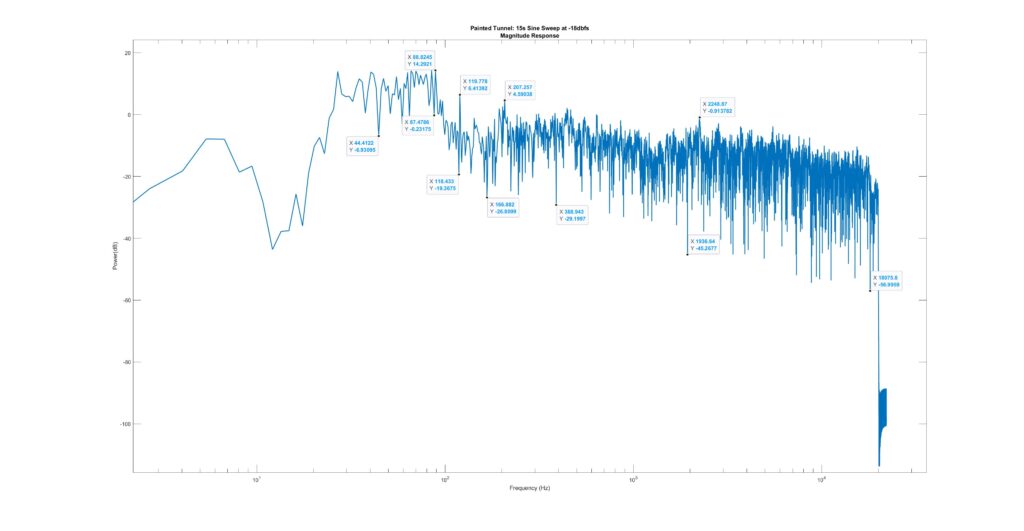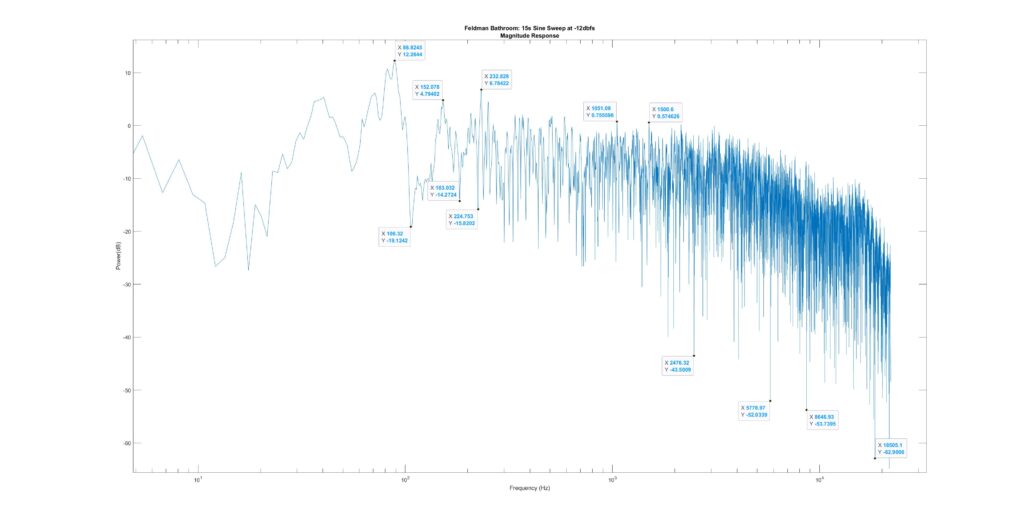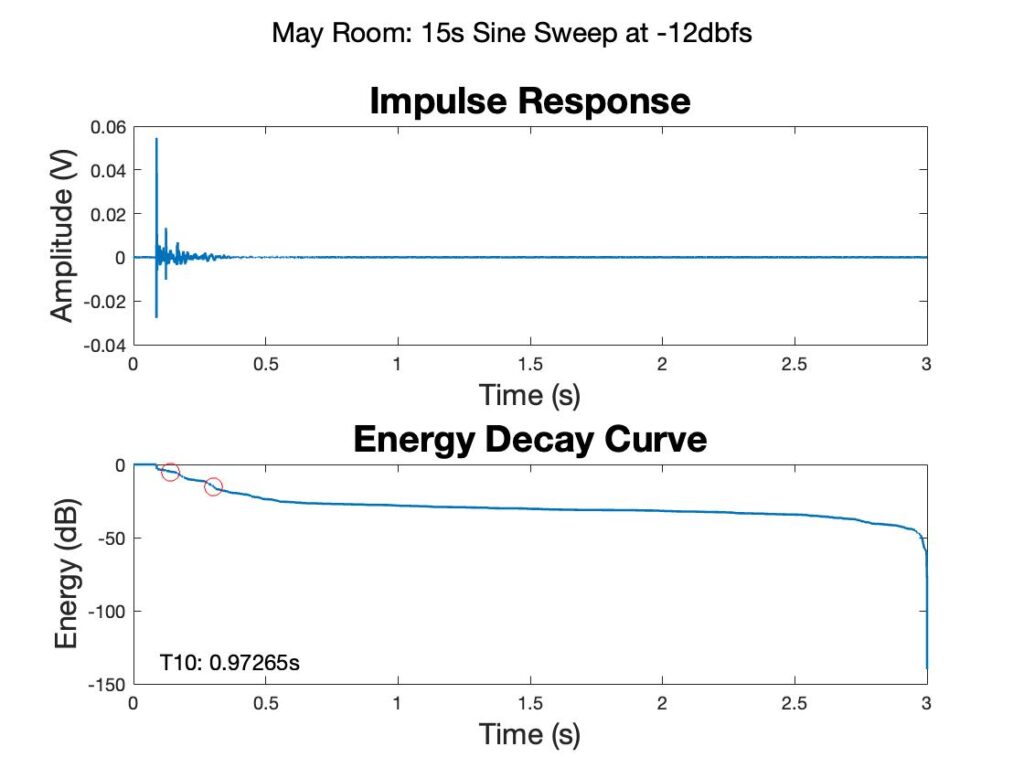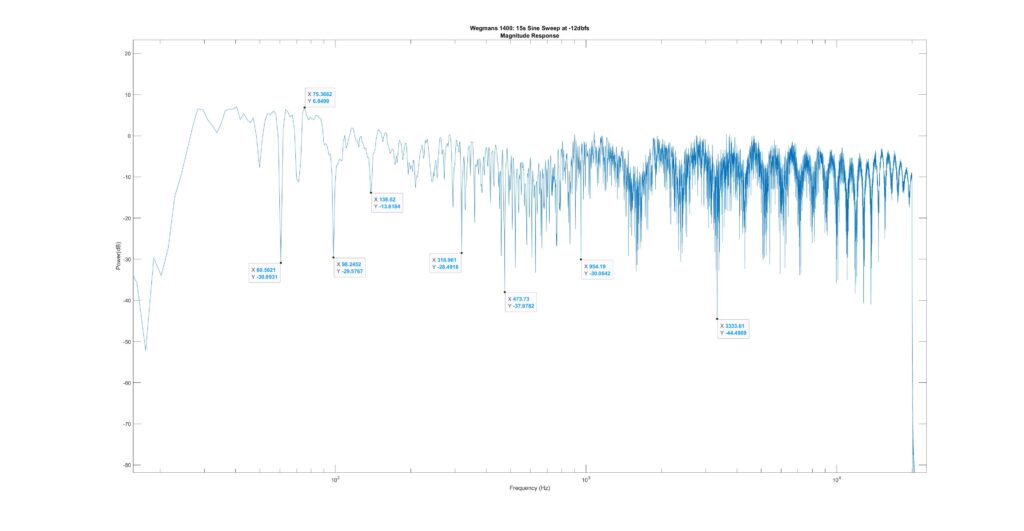Joe Bumpus, Junwei Ma, Nick Muscarella
Introduction
The University of Rochester has a thriving a cappella culture, its groups known to sing anywhere and everywhere. Whether it be through performing for first-year students in a corridor or finding themselves practicing in the restroom of a lecture hall, almost all a cappella singers have developed a strong preference for a particular rehearsal or performance space. Few singers, however, are able to understand their preference on a scientific, acoustical level. In order to more deeply understand the connection between opinions and acoustics, we are going to measure the acoustic properties of candidate rooms and analyze our findings in hopes of finding a correlation.
Every room has its own reverberant characteristics determined by the architecture of the room itself. When sound is generated in a room, the dimensions and materials within the room dictate whether or not energy will easily be absorbed. Different materials and the shape of the walls can have a different effects on the reflection and absorption of sound. For example, a large concert hall full of fabric chairs will lead to a stronger absorption, thus less reverb, than one with a completely open floor. Beyond reverberation, the dimensions of a room will also factor into the resonance of the room. The resonant frequencies of a room are specific frequencies at which the air particles will vibrate at a higher than normal amplitude.
To measure these two-room characteristics, we will be performing exponential swept sine measurements throughout our college campus. This will allow us to find the impulse response, necessary for reverberation time, and the frequency magnitude response. We hypothesize that by analyzing these two qualities and comparing them with a cappella singer preference, we may find that the resonance of a room and certain reverberant characteristics play key roles in the opinions of a cappella singers.
Theoretical Background & Methods
An impulse can be defined as a signal of extremely short duration. Though the function for an impulse is different in analog and digital fields (analog/continuous system will use Dirac Delta function and digital/discrete-time system will use Kronecker Delta function), they can both be modeled as a signal consisting of zeros at all x values except for x=0 at which y=1 [4]. The generated feedback to an impulse in a room is called the impulse response.
A sine sweep is a useful technique for measuring room resonances. With different frequencies comes different wavelengths, all interacting with a room differently depending on its dimensions. Using a long duration sweep-frequency signal allows us to view the frequency magnitude response at a high resolution, picking out resonances and other frequency dependent acoustic characteristics analytically. In this case of study, we set the frequency range of our sine sweep to match the human hearing range in order to view what our singers may be hearing.
Convolution is a mathematical operation defined as the integral of the product of the two functions after one is reversed and shifted [1]. In the analog system of this experiment, the signal will come MATLAB’s built in impulseResponseMeasuerer tool into a JBL LSR310S sub (with builtin crossover) and from the sub to a JBL 305P MkII monitor. This speaker system outputs the signal and produces a reverb in the room, which then passes into a microphone Behringer ECM8000. Each of these processes can be considered in a convolutional way in a discrete-time system. For example, when the signal passes through the room, the passing sound will be taken as a convolution calculation between the dry signal and the room’s impulse response.
To attain the impulse response from our swept-sine measurement, one must compute the deconvolution of the output and input signals. In MATLAB, this is done automatically by impulseResponseMeasurer. This impulse response can then be used to find the energy decay curve. With this, we are able to find the reverberation time, typically discussed as the room’s T60. T60 is defined as the measure of time after the sound source ceases that it takes for the sound pressure level to reduce by 60dB [3]. However, in real physical space, there are often background ambient noises raising the noise floor that make a decrease of 60dB impossible. As more practical quantities, we found ourselves using either T30, T20, or T10 measurements. The T30 of space, for example, is two times the time taken after the pressure level is reduced by 30dB. These serve as accurate T60 estimates.
Methods
We make use of Matlab in this project to measure the impulse response. Matlab has a function called ImulseResponseMeasuer, which can output audio and analyze the input audio. So we connect the audio interface with the computer. The Matlab output audio, in this case, the sine sweep, from the interface to the speaker. Then we catch the sound by a microphone, which then goes into the interface back to the Matlab. Matlab can do the deconvolution calculation between the output signal and input signal, finally computing the impulse response.
Data & Analysis
Survey
In order to have the necessary data to run this project (singing location opinions, acoustic preferences, etc.) we sent a survey to all University of Rochester a cappella groups. Survey questions included:
- “What a cappella group are you in?”
- “What is your vocal range? Please answer in the form of note to note. Example: ‘F2 to D4’”
- “What is your vocal part?” (with multiple choice answers of Soprano, Mezzo, Alto, Tenor, Baritone, Bass, and the ability to fill in their own)
- “Where is your favorite place to sing on campus? We are looking for particularly ATYPICAL spaces (a specific staircase, hallway, or even campus bathroom) but all answers are valid!”
- “Where is your LEAST favorite place to sing on campus that is relatively popular (a large performance space, dedicated rehearsal space, etc.)?”
- “What are your thoughts on room acoustics? (Do you like any specific feature in a room? Do you like a room with a lot of reverb or a very dry room? Are there any acoustical challenges you find with particular kinds of spaces? Etc.)”
Although the survey was sent to all groups, the data we received was primarily from the Midnight Ramblers (five responses) and Yellowjackets (six responses). Looking through their responses, we were able to narrow in two preferred locations for each group, two total generally disliked spaces, and one controversial (both liked and disliked) space for testing. These are as follows, with the vocal part who listed the space noted in parentheses:
- Midnight Ramblers:
- Meliora staircase (tenor, baritone, bass)
- Painted tunnel (bass)
- Yellowjackets:
- Douglass bathroom, outside of Feldman (2 tenors)
- Spurrier (1 tenor)
- Least favorite:
- May Room (3 Ramblers: 2 tenors, 1 bass, 2 YJs: 2 tenors)
- Wegmans 1400 (2 YJs bass)
- Discrepancy:
- O’Brien Rehearsal Room (YJ (tenor) likes, MR (bass) says it is their least favorite)
With this list, we went around campus to each spot running exponential swept-sine measurements as mentioned above.
Midnight Ramblers Preferred Spaces
Meliora Staircase


The Meliora Hal staircase was preferred by a tenor (vocal range 92.5-466Hz), a bass (vocal range 62-349Hz), and a baritone (vocal range73.4-392Hz) member of the Midnight Ramblers. Looking at the magnitude response, we see a maximum at 48.45Hz, a large dip at 133.24Hz, and a minimum at 10.6kHz. There is a significant amount of high-frequency noise, likely corresponding to a bright or shimmery echo with high harmonics introduced. This space had a higher noise floor, leaving us using a T20 measurement. The T20 time, 1.609s, corresponds to a very present but not overwhelming reverb.
Painted Tunnel


The Painted Tunnels was preferred by a single bass with a vocal range of 62-350 Hz. Note the alternating peaks at 119/118Hz as well as 88/87Hz where there is immediately a dip followed by a peak exactly 1Hz later. We attributed this to reflections about the tunnel. There is an absolute minimum at 18.0758kHz, which is exactly the 407th multiple of the dip seen at 44.4122Hz. There is an absolute maximum as well located at 88.8245Hz. We found this exact absolute maximum present in one other room as well. We initially contributed to the crossover, but now believe it may have just been a random chance. The T30 time is very long, as one would expect of such a reverberant space.
Yellowjackets Preferred Spaces
Spurrier Rehearsal Room
The Spurrier Rehearsal Room was preferred by one tenor with a vocal range of 98.0-440.0Hz. As can be seen above, the frequency response is relatively flat with decent high frequency information introduced. There is a peak at 62Hz and a significant dip at 133Hz (which could possibly be the crossover, but is likely the room itself as this is not present in other measurements). The absolute minimum is at 494Hz. The T20 is 0.93s, on the short side but long enough to add shimmer to the vocals. The reason why the tenor may like this room is because it has a great performance in across nearly the whole frequency range, introducing some high harmonics and giving a boost to powerful bass singers in the group.
Feldman Bathroom


The Feldman Bathroom was preferred by two tenors with vocal ranges of 87-350Hz and 98-523Hz, respectively. As with the painted tunnel, there is an absolute maximum at exactly 88.8245Hz. There is also an absolute minimum at 18.505Khz, exactly the 174th multiple of 106.32 Hz. The fact that two tenors prefer this room came as a surprise considering the rather large ~100 Hz dip and visible lowpass filtering, as well as the fact that there is an overall lack of reverb in this room, with a T20 time of only 0.66 seconds. Although there is a present lowpass, though, losing some high harmonics, the noisy magnitude response reflects an overall harmonic richness to the space.
Least Favorite Spaces
May Room


The May Room was several people’s least favorite space: three Midnight Ramblers (two tenors and one bass) and two Yellowjackets (both tenors). Looking at the magnitude response, we see a maximum at 39Hz (below any human vocal range) and low dip at 100.9Hz. There is a trough beginning at the 100.9Hz mark going to roughly 110Hz, causing loss right around the frequencies these male voices are often singing. Looking toward the high frequencies we see significant comb filtering, likely due to reflections off of the walls and floor. This causes a loss of high frequency information which is extremely undesirable for singing clarity. As can be seen on the impulse response and energy decay curve plots, the T10 shows some reverb but nothing special for singing. Notably, though, the May Room has a very loud HVAC. With this high noise floor, high harmonic loss, and there being no prevalent resonances to excite, we can see why this room is not preferred.
Wegmans 1400


Wegmans 1400 was disliked by two bass members from the Yellowjackets, with vocal ranges of 55-130Hz and 62-262Hz. There is an absolute maximum at 75.3662Hz, and briefly following as well as preceding this maximum there are two large dips at 60 and 98Hz. This would explain why the two bass singers do not like this room. There is also an absolute minimum at 3333.61Hz, the 24th multiple of the 138.62Hz dip. 75Hz is a fundamental frequency as we can see its 12th multiple (900Hz) also has a peak. The impulse response for this room is very short, hinting that while this room may be great for classrooms or other speaking events, it is not a desirable location for singing.
Discrepancy Location
O’Brien Music Room
We focused in on the O’Brien Music Room as a particular space of interest due to differing opinions received in our survey. While a Midnight Rambler bass says this room is his least favorite, a Yellowjacket tenor noted being particularly fond of this room. The frequency response has a peak at 39Hz (far below any human vocal range) and a dip at 131Hz, a tough frequency to lose for many male singing voices. There is also an absolute minimum at 12kHz. The T20 is fairly short at about 0.69s. The reason why this room is controversial might be from the frequency response. The frequency response has a huge low end, and the second point is that there are a lot of results from comb filters, in which you can see the frequency loses a lot of information at high end.
Conclusion
Looking at all gathered data together, there are several clear conclusions we can draw between singer preference and the measured acoustic properties of these spaces. All preferred spaces have fairly noisy high end responses, possibly showing many high harmonics being introduced as well as a very desirable, shimmery reverb (depending on the reverb time). The two least favorite spaces have significant comb filtering and very low noise, largely flat magnitude responses. They also feature reverb tails that are not particularly optimal for singing, both below one second. The O’Brien Music Room, our discrepancy space, has an extreme dip at 131Hz, a frequency many bass singers would find themselves at quite often. However, it leaves much of the tenor frequency range fairly flat with lots of high harmonic information introduced. Over all, with the exception of the Feldman Bathroom, all preferred spaces have decently long reverb tails (minimum of one second) and introduced high harmonics. Undesirable spaces showed flat responses with significant comb filtering, likely due to hard surface walls and floors causing early reflections.